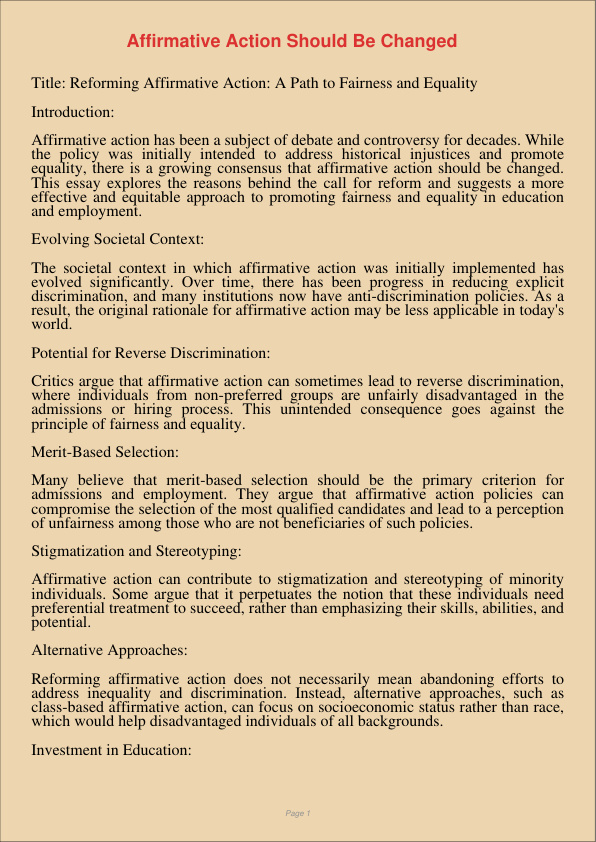Affirmative Action Should Be Changed
Jan 9, 2024
affirmative action
changed
Biology
Marketing

Title: Reforming Affirmative Action: A Path to Fairness and Equality
Introduction:
Affirmative action has been a subject of debate and controversy for decades. While the policy was initially intended to address historical injustices and promote equality, there is a growing consensus that affirmative action should be changed. This essay explores the reasons behind the call for reform and suggests a more effective and equitable approach to promoting fairness and equality in education and employment.
Evolving Societal Context:
The societal context in which affirmative action was initially implemented has evolved significantly. Over time, there has been progress in reducing explicit discrimination, and many institutions now have anti-discrimination policies. As a result, the original rationale for affirmative action may be less applicable in today’s world.
Potential for Reverse Discrimination:
Critics argue that affirmative action can sometimes lead to reverse discrimination, where individuals from non-preferred groups are unfairly disadvantaged in the admissions or hiring process. This unintended consequence goes against the principle of fairness and equality.
Merit-Based Selection:
Many believe that merit-based selection should be the primary criterion for admissions and employment. They argue that affirmative action policies can compromise the selection of the most qualified candidates and lead to a perception of unfairness among those who are not beneficiaries of such policies.
Stigmatization and Stereotyping:
Affirmative action can contribute to stigmatization and stereotyping of minority individuals. Some argue that it perpetuates the notion that these individuals need preferential treatment to succeed, rather than emphasizing their skills, abilities, and potential.
Alternative Approaches:
Reforming affirmative action does not necessarily mean abandoning efforts to address inequality and discrimination. Instead, alternative approaches, such as class-based affirmative action, can focus on socioeconomic status rather than race, which would help disadvantaged individuals of all backgrounds.
Investment in Education:
A more effective way to address inequality is through investing in early education and providing equal opportunities for all students, regardless of their background. This approach can help level the playing field from the outset, rather than addressing disparities through affirmative action later on.
Holistic Review and Diversity Initiatives:
Institutions can adopt holistic review processes and diversity initiatives that consider a broad range of factors, including socioeconomic background, personal experiences, and obstacles overcome, to achieve a diverse and inclusive environment without explicit preference based on race.
Conclusion:
Affirmative action has been an important policy in addressing historical injustices, but the evolving societal context, potential for reverse discrimination, and concerns about fairness call for a change in how we address inequality and promote diversity. Reforming affirmative action and exploring alternative approaches can help us strike a balance between rectifying historical injustices and ensuring a fair, merit-based selection process in education and employment. It is essential to have a robust and inclusive dialogue on this topic to develop policies that better align with our evolving understanding of equality and justice.